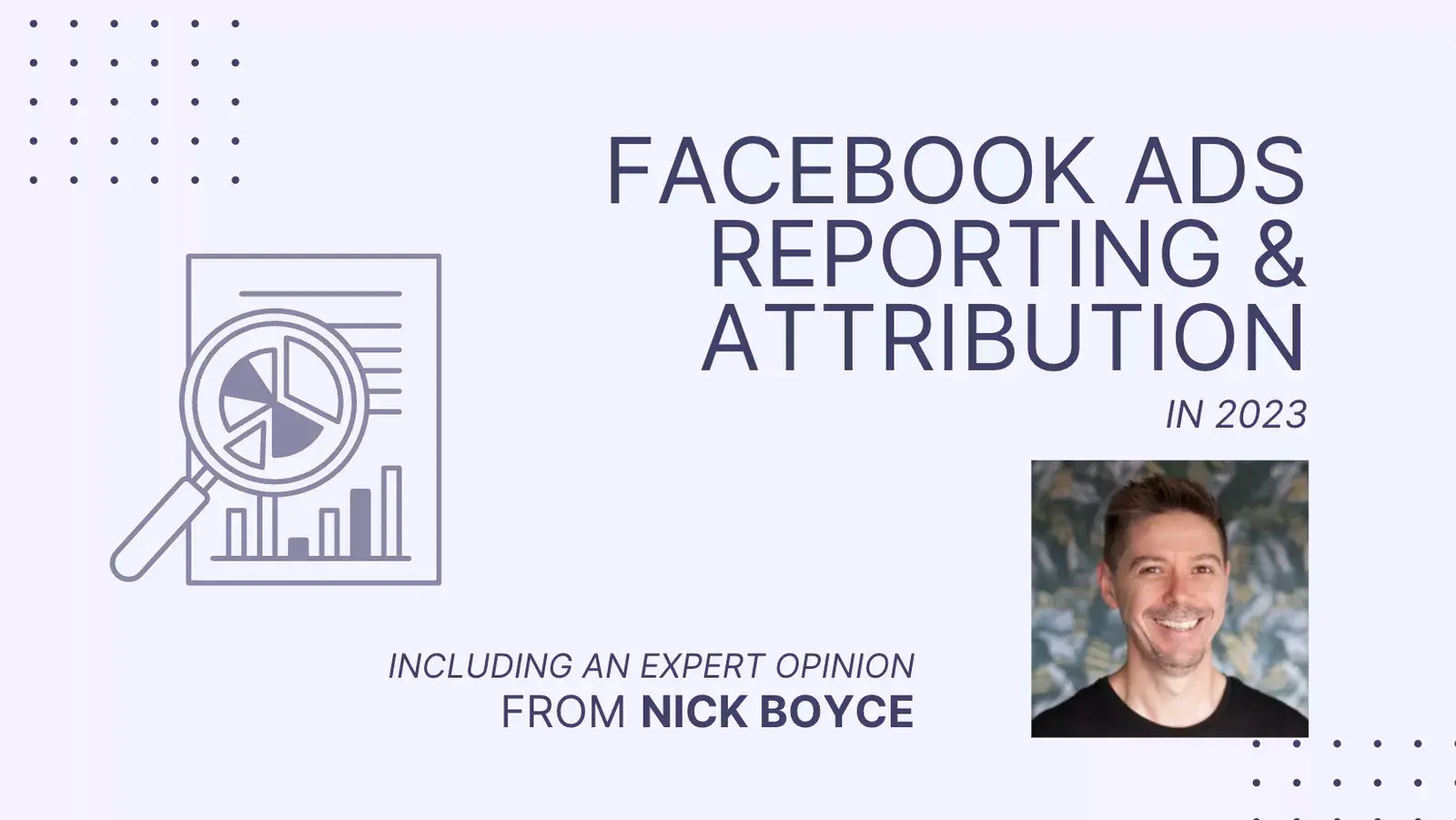Paid Social Blueprints
Facebook ads reporting & attribution in 2023: how to measure your ad campaigns right
Keep up with the latest best practices for Facebook ads reporting and attribution. Learn to measure your Facebook ad campaigns effectively with this guide.
With the ever-evolving landscape of the Facebook ads platform and privacy regulations, keeping up with the latest best practices for Facebook ads reporting and attribution can be challenging. However, measuring the success of your Facebook ad campaigns is critical to ensure that you are getting a positive return on your advertising investment.
In this blog post, we'll explore the latest developments in Facebook Ads reporting and attribution in 2023 and provide insights from an expert and strategies for effectively measuring your Facebook ad campaigns.
How new privacy policies affect Facebook ads data
Over the past few years, Facebook ads reporting and attribution have undergone significant changes. These changes have affected how advertisers measure the success of their Facebook Ads campaigns and optimize Facebook ads.
The biggest challenge for advertisers was, of course, the introduction of iOS 14 by Apple. Before, Apple's privacy policy required users to explicitly opt out to prevent data tracking by apps, including Facebook. Data shows that most Facebook users didn't restrict access to their data, making it easy for businesses to build detailed Facebook ads reports. The introduction of iOS14, however, has limited the amount of data that can be tracked through Facebook's built-in measurement tools, such as the Facebook Pixel, unless users give explicit consent to share their device's identifier with advertisers (IDFA).
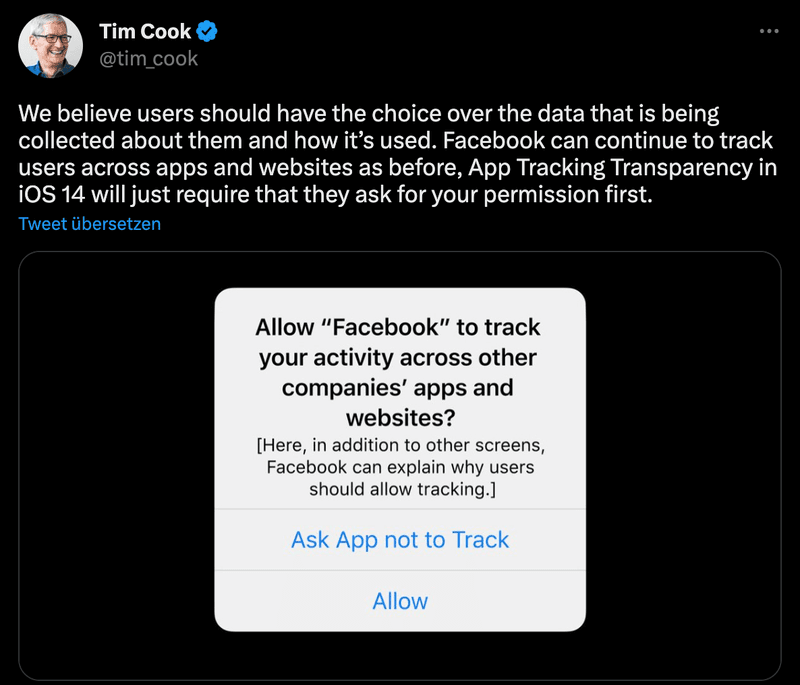
With the release of iOS 14, Facebook's ability to track conversions and attribute them to specific ads has been impacted. When you don't know which campaigns are getting you the most conversions, Facebook ads reporting becomes challenging. The new restrictions included less event tracking by Facebook Ads and is now limited to 8 conversions per ad account. It also capped the number of campaigns and adset in ad campaigns for app install campaigns and targeting restrictions with custom and lookalike audiences.
The biggest challenge, therefore, became Facebook ads reporting and attribution. With the growing concerns over Apple's new privacy and data security rules, Facebook had to make several updates to its platform, which has limited the amount of Facebook ads campaign data available to advertisers.
Despite these changes, there are still ways for advertisers to measure the success of their Facebook Ads campaigns and attribute conversions.
Facebook ads reports in the post-iOS14 era
After iOS, Facebook advertisers had to rely on Apple's SKAdNetwork API data sources to continue giving advertisers insights into their Facebook ads performance. However, it resulted in reporting limitations due to fewer available data and delays. Advertisers may experience delayed conversion reporting, resulting in lower conversion tracking accuracy. Optimization became more complex as attribution windows for active campaigns got shorter, and fewer audience insights were available due to the depreciation of specific breakdowns, such as age, gender, region, and placement.
We've asked Nick Boyce, Data & Insights Director of Spin Brands, how he and his team approach Facebook ads reporting in post iOs14 era, and this is what he said:

"I think there is a hierarchy of needs when it comes to attribution. Platform data is generally enough to make day-to-day optimizations, but it shouldn't be used to drive bigger business decisions. We generally like to use a first-party data source to measure directional performance, as well as something like Google Analytics. Taken individually, none of these measurements will tell the whole story, but the key is understanding broader cause and effect."
Despite iOS14 changes, there are still ways for advertisers to measure their Facebook Ads metrics and attribute conversions.
Facebook ads reporting in the Ads Manager
While multiple Facebook ads reporting tools are available to track your ad performance, the most straightforward and convenient way to start is still Facebook Ads Manager. Facebook Ads Manager is available for all ad accounts and is still the most popular tool for creating, managing, and monitoring campaign performance. It provides a wealth of data and insights that help you understand your top Facebook ads and identify improvement areas.
Since the Facebook ads algorithm relies on Facebook ad performance data to optimize campaign delivery, this data is still crucial to look at when evaluating ad performance and optimizing Facebook campaigns.
However, it's important to note that not all data obtained through Facebook Ads Manager can be entirely relied on due to the current privacy policies and iOS14 updates. As a result, you are likely missing some events and conversions. Despite this, some valuable ad metrics such as CPMs (cost per thousand impressions), engagement data (likes, comments, shares), and inbound clicks (the number of clicks that lead to your website or landing page) are still available to advertisers.
One major thing that many advertisers forget about is naming conventions. Now they are more crucial than ever! Not only will they help you to save time on Facebook ads reporting, but also provide more insights into your Facebook advertising and ad strategy. Due to the privacy policy updates, businesses won't see important metrics such as purchases, subscriptions, and ROAS while using Facebook ads breakdowns (for example, age, location, or placement).
Suppose you want more audience insights and determine which customer segment responds better to a new ad creative. In that case, you will need to use "extra segmented targeting in combination with good naming conventions for your paid campaigns, at least for testing campaigns and ad sets. Doing so will get bullet-proof data, similar to the earlier available breakdowns. This goes against best practices for Facebook ads (or digital marketing in general). However, it could provide you with a valuable Facebook ads report when defining a future ad strategy and allocating budgets.
Server-side Facebook ads reporting
One of the most effective ways to do facebook ads reporting is through server-side tracking. This tracking method allows advertisers to track conversions and other relevant metrics by sending data directly from the server to Facebook rather than relying on the Facebook Pixel or other tracking tools.
Server-side tracking has several advantages for your reporting process over browser tracking, including greater accuracy and the ability to track conversions from all users, including those who don't have browser tracking enabled. In addition, server-side tracking can help advertisers comply with privacy regulations and ensure they are not collecting any personally identifiable information from users, while still facilitating your Facebook reports.
Adapting to new privacy policies and advertising changes in Facebook Ads can be done effectively with the Facebook Conversions API (CAPI). Unlike the Facebook Pixel or other marketing tools, which tracks data through a user's browser and are affected by the iOS 14 update, the CAPI enables you to monitor conversions via your website's server. The CAPI eliminates the need for cookies or app tracking, making it a reliable option for tracking ad performance.
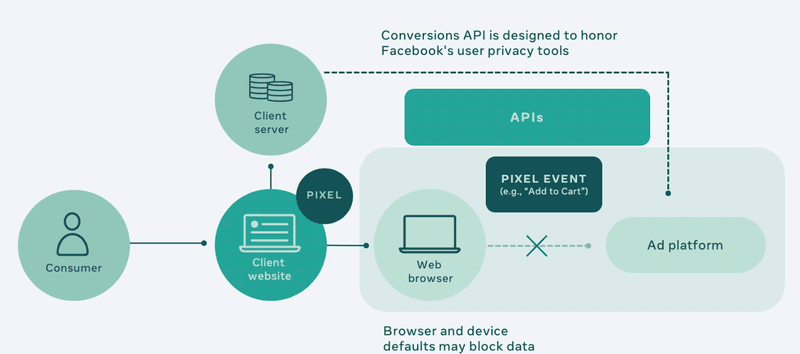
The CAPI provides a comprehensive view of your conversion funnel by offering data for targeting and reporting audience insights and optimization. With the obsolescence of cookies, server-side tracking is the future. Using Facebook's CAPI together with Google Tag Manager gives you great control over conversion tracking.
How to do attribution right for your Facebook ad campaigns
IOS14 and privacy changes negatively impacted attribution for Facebook ads marketing campaigns. However, there are many ways to determine which specific ads and campaigns are driving conversions and other desired actions on your website.
Facebook ads reporting attribution
The reliability of Facebook Ads attribution has been impacted by Apple's new privacy policy and App Tracking Transparency framework. To keep it under control, Facebook has introduced Aggregated Event Measurement to limit data tracking and comply with the new framework. However, the limited data tracking and aggregated event reporting can result in lower conversion tracking accuracy and delayed Facebook ads reporting.
Facebook Ads native attribution accuracy will vary for different businesses and industries, depending on their target audience and how they use Facebook Ads. For example, some companies may see only a small impact, while others, relying heavily on iOS mobile users, may significantly decline conversion tracking accuracy. Generally, it's essential to be prepared to track Facebook ads performance differently and adjust your measurement and optimization strategies based on multiple data sources.
Some advertisers say that because of the lost visibility in Facebook ads reporting, most conversions get attributed to campaigns with many retargeting audiences. However, looking at the ad spend and assuming that algorithm tries to deliver mostly great Facebook ads, it might not be true. Suppose you want to ensure that your results come from new customers. In that case, the only way to do Facebook ads reporting is to look at the server data, especially if your goal is customer acquisition rather than revenue per customer.
Google Analytics
Google Analytics as a reporting tool can be used not only for google ads but also to provide a more comprehensive view of your Facebook ad performance and attribution.
Adding UTM parameters is a widely used approach to merging Google analytics data with Facebook ads reporting data. Add UTM parameters to your ad links to accurately attribute conversions to specific Facebook Ads campaigns and ad sets. UTM parameters provide additional information to Google Analytics about your traffic source, medium, and campaign. For example, if you use ad id in the UTM parameters, you will see conversions directly attributed to your Facebook ads!

First-party data sources
First-party data is collected directly from your website, app, or other properties. In the context of Facebook Ads reporting, first-party data is a precious source for ad set and optimization. Simple insights from your users or customers can be used for Facebook ads reporting, daily optimization, and campaign planning.
Website visit data can help you get more insights into the customer journey and trends. Pages visited, products viewed, and time spent on a website can be used to inspire ad creatives and campaign strategies based on the interests and behaviors of your website visitors. Take a look into purchase data as well - information about past purchases, such as items bought, frequency of purchases, and amount spent. Although a product may perform better on different marketing channels, you will identify the general trends and can implement them in a future Facebook ad campaign.
Use customer email addresses to create valuable custom and lookalike audiences. You can upload a hashed list of customer email addresses to Facebook ad accounts and build a lookalike audience. However, you must be very careful and follow anonymization rules and privacy policies.
Shall I use third-party Facebook ads reporting tools to succeed in 2023?
The changes to Facebook's attribution capabilities due to iOS 14 will require advertisers to adapt and find new ways to measure the effectiveness of their campaigns. Another way to approach facebook ads reporting in 2023 and evaluate the success of your Facebook Ads campaigns is by using alternative measurement or third-party tools. Of course, many software solutions on the market could be extremely valuable if you are searching to bring your Facebook ads reporting to the next level and understand in detail how your social media channels are affecting the overall company's performance metrics.
We've asked Nick Boyce's opinion on the topic of using third-party attribution tools:
"No attribution tool is perfect. I'm impressed with what Triplewhale is building and open-minded to third-party attribution tools in general. But so far, we are satisfied with what we get by blending platform, first-party, and Google Analytics data", says Nick from Pollenary.
Build your custom Facebook ads reporting tool
If you want to automate Facebook ads reporting and bring platform, first-party, and Google Analytics data together, Kitchn.io has a solution for you. Kitchn.io allows you to pull data from multiple sources in one place with just a few clicks and build custom, automated reports.
Kitchn.io Facebook ad reporting tool allows you to merge all valuable insights in Google Spreadsheets, Airtable, or Notion so that you can build a custom report for each use case. Since most teams know how to work with sheets, it makes Facebook ads reporting easier and accessible to everyone.
Facebook Creative Reporting in Gsheets | Kitchn.io template
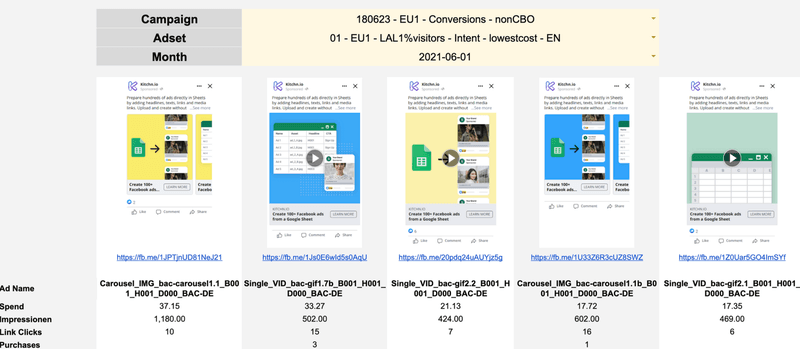
For example, you can combine data from the Facebook ads API and Google Analytics to analyze and determine your best Facebook ads. Some metrics, such as ad spend and results, will be taken directly from the platform. Conversion data can come from different channels, such as your backend or google analytics. With Kitchn.io, you can merge multiple data sources based on the ad id to get valuable, actionable insights.
Creative Reporting by Kitchn.io | A screenshot of the automation
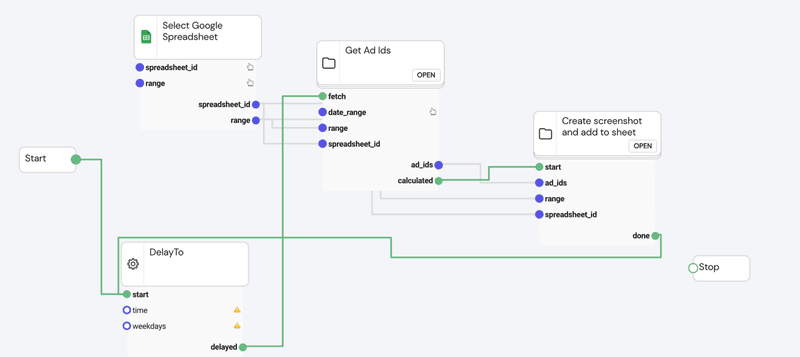
You can use ready-to-use Kitchn.io's pre made templates for Facebook ads reporting (also for TikTok, Google, Twitter, and Snapchat ads) or build your automated tool for custom reports. Learn how foodspring has automated their paid social ads reporting with Kitchn.io.


